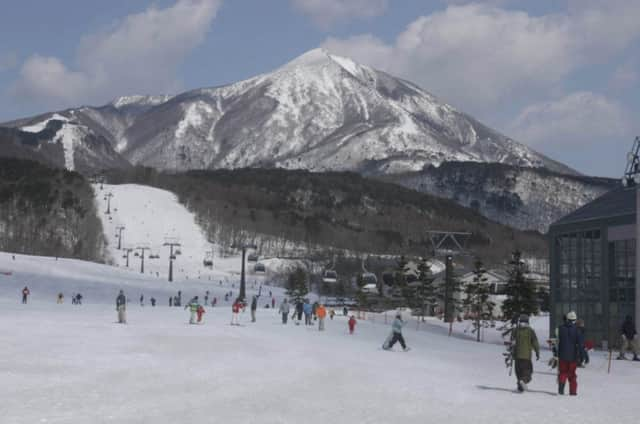Travel: Slopes and spas of alpine Japan


‘She’s going to feel like they’ve unzipped her skin and filled her with baking powder!” That was easily the most entertaining British commentary I heard while watching the Sochi Olympics.
It was inspired by the new sport of slopestyle, although Team GB competitor Katie Summerhayes had little reason to feel explosively excited because her somersaults on skis did not win her the medal that exuberant commentator Tim Warwood thought they had.
CONNECT WITH THE SCOTSMAN
Advertisement
Hide Ad• Subscribe to our daily newsletter (requires registration) and get the latest news, sport and business headlines delivered to your inbox every morning
A month later and I’m facing an unexpected chance to try the sport myself. My instructor Riki has just shot past me with a mischievous grin, ready to demonstrate his skills as a former competitor at national level.
Now it’s my turn to jump. Or is it? Unsure whether he actually means me to follow, I veer off to one side, before turning back and deciding to go for it. Sadly my dithering loses me so much speed that I fail to become airborne at all and am in serious danger of sliding backwards instead. It’s unlikely that Tim would mention baking powder to describe my efforts if he was here, unless to compare me to a loaf failing to rise due to a complete lack of the stuff. Still, I have done my first “jump”.
I’m in Japan, where the focus is already very much on 2020 when the summer Olympics will be held in Tokyo for the first time in more than 50 years. Like many international sporting events, it brings the promise of a major tourism boost. I am skiing in a region which many here hope will benefit particularly this time – Fukushima.
Just an hour and a half north of the capital by bullet train, the region was devastated by the deadly 2011 earthquake, tsunami and nuclear meltdown. By the following year the number of foreign tourists visiting Japan was reported to have returned to pre-earthquake levels. But few go to Fukushima, now forever as synonymous with nuclear disaster as Chernobyl. The obvious question for any visitor is, “Is it safe?”
Unfortunately there is no simple answer. Experts and officials are divided over what the radiation levels are, the health risk they present and whether monitoring is adequate. That said, the most dangerous period is over and three years on the chances of experiencing any ill effects from spending a few weeks here are arguably zero. The only UK government travel advice is the fairly obvious warning not to visit any of the remaining exclusion zones around the nuclear plant.
Advertisement
Hide AdOne of the most enticing attractions in the region is the Alts Snow Park and Resort at Mount Bandai. Around 70 miles inland from the site of the disaster it is “100 per cent safe”, according to general marketing manager Kei Ishiuchi, who has skied and surfed around the world. He admits that the public are still afraid though, and while skiing helter-skelter through the trees is great fun, I can’t help thinking briefly about the fact that any radiation still here is most likely to be in wooded mountainous areas just like this.
It’s easy to relax in the resort which, like Kei, is laid back and friendly. It advertises itself as having English-speaking staff on duty 24:7 and at dinner the waitress goes to great lengths to explain the dishes to me in detail. The food is delicious and, being Japanese, beautiful to look at, which is good, as I spend far longer doing that than I would normally owing to my less than impressive chopstick skills.
Advertisement
Hide AdLuxuriating later in the hotel onsen, or traditional Japanese spa, it strikes me as odd, given Japan’s conservative reputation, that one of their most beloved pastimes is hanging out together naked in pools. Men and women bathe separately, however. Onsens originate from natural hot springs that once attracted footsore travellers on the road, and the enterprising locals who built inns to cater for them. In the nearby the town of Aizu-Wakamatsu the Higashiyama Onsen Harataki offers a more authentic and decadent spa experience and traditional Japanese-style ryokan rooms with futons, low tables and legless chairs. Lying down, I’m lulled by the hypnotic sound of a waterfall cascading down the hillside outside. Dinner here is a bit of a mystery tour as a seemingly endless supply of delicate bowls are put before me by smiling waitresses who know only slightly more English than I do Japanese. Whatever it is, it’s tasty.
Meanwhile, although many want to escape the nuclear spectre, some want to turn the Fukushima power plant into a future visitor attraction. In the south of the country, the Nagasaki Atomic Bomb Museum is one of the world’s oldest and most famous examples of what is now known as dark tourism.
Nearly 70 years after the horrific Second World War attack, it serves as a powerful reminder of the lethal nature of nuclear weapons. Maybe Fukushima could benefit from something similar. But if that doesn’t happen, there are already good reasons to visit.
For more information on visiting Japan and Nagasaki contact the Japan National Tourism Organisation and Nagasaki Tourism Association (www.seejapan.co.uk, www.at-nagasaki.jp/foreign/english)
SCOTSMAN TABLET AND IPHONE APPS